Comprehensive Report on Infant Mortality in Kenya: Analysis
VerifiedAdded on 2020/04/21
|10
|2391
|92
Report
AI Summary
This report provides a comprehensive analysis of infant mortality in Kenya, examining the trends, contributing factors, and government initiatives aimed at reducing child mortality. The report highlights the significant decline in infant mortality rates since the 1990s, while also acknowledging that the rates in rural areas and urban slums remain considerably higher. Key contributing factors discussed include socio-economic disparities, lack of access to healthcare, poor maternal health and nutrition, and inadequate health literacy. The report explores current approaches, such as the UNICEF-funded programs and the community health strategy, and identifies their limitations. Recommendations are made to improve resource allocation, enhance accessibility and availability of services, promote health literacy, and address socio-economic disparities to achieve further reductions in infant mortality and meet the Millennium Development Goals.

Running head: INFANT MORTALITY IN KENYA
Infant mortality in Kenya
Name of the student:
Name of the university:
Author note:
Infant mortality in Kenya
Name of the student:
Name of the university:
Author note:
Paraphrase This Document
Need a fresh take? Get an instant paraphrase of this document with our AI Paraphraser
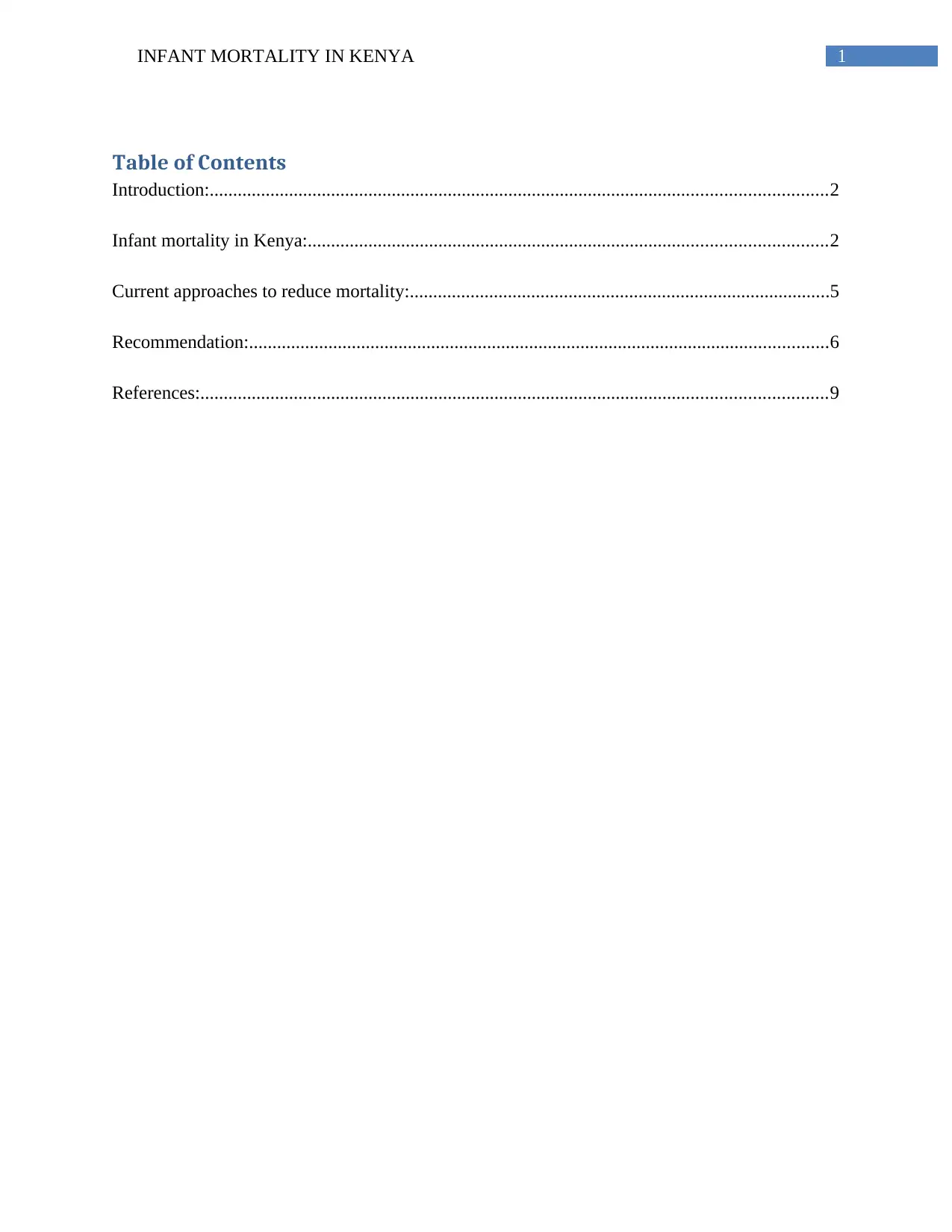
1INFANT MORTALITY IN KENYA
Table of Contents
Introduction:....................................................................................................................................2
Infant mortality in Kenya:...............................................................................................................2
Current approaches to reduce mortality:..........................................................................................5
Recommendation:............................................................................................................................6
References:......................................................................................................................................9
Table of Contents
Introduction:....................................................................................................................................2
Infant mortality in Kenya:...............................................................................................................2
Current approaches to reduce mortality:..........................................................................................5
Recommendation:............................................................................................................................6
References:......................................................................................................................................9
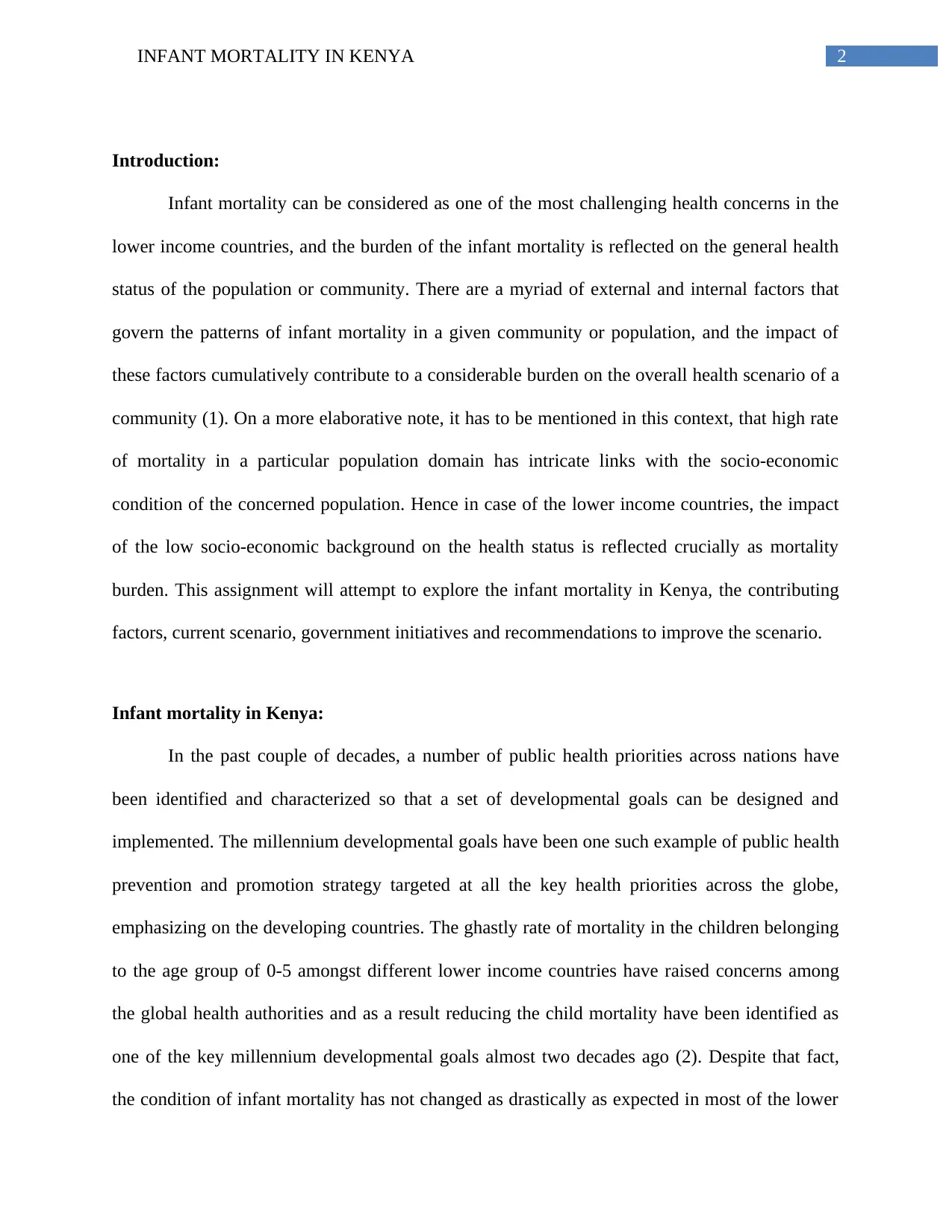
2INFANT MORTALITY IN KENYA
Introduction:
Infant mortality can be considered as one of the most challenging health concerns in the
lower income countries, and the burden of the infant mortality is reflected on the general health
status of the population or community. There are a myriad of external and internal factors that
govern the patterns of infant mortality in a given community or population, and the impact of
these factors cumulatively contribute to a considerable burden on the overall health scenario of a
community (1). On a more elaborative note, it has to be mentioned in this context, that high rate
of mortality in a particular population domain has intricate links with the socio-economic
condition of the concerned population. Hence in case of the lower income countries, the impact
of the low socio-economic background on the health status is reflected crucially as mortality
burden. This assignment will attempt to explore the infant mortality in Kenya, the contributing
factors, current scenario, government initiatives and recommendations to improve the scenario.
Infant mortality in Kenya:
In the past couple of decades, a number of public health priorities across nations have
been identified and characterized so that a set of developmental goals can be designed and
implemented. The millennium developmental goals have been one such example of public health
prevention and promotion strategy targeted at all the key health priorities across the globe,
emphasizing on the developing countries. The ghastly rate of mortality in the children belonging
to the age group of 0-5 amongst different lower income countries have raised concerns among
the global health authorities and as a result reducing the child mortality have been identified as
one of the key millennium developmental goals almost two decades ago (2). Despite that fact,
the condition of infant mortality has not changed as drastically as expected in most of the lower
Introduction:
Infant mortality can be considered as one of the most challenging health concerns in the
lower income countries, and the burden of the infant mortality is reflected on the general health
status of the population or community. There are a myriad of external and internal factors that
govern the patterns of infant mortality in a given community or population, and the impact of
these factors cumulatively contribute to a considerable burden on the overall health scenario of a
community (1). On a more elaborative note, it has to be mentioned in this context, that high rate
of mortality in a particular population domain has intricate links with the socio-economic
condition of the concerned population. Hence in case of the lower income countries, the impact
of the low socio-economic background on the health status is reflected crucially as mortality
burden. This assignment will attempt to explore the infant mortality in Kenya, the contributing
factors, current scenario, government initiatives and recommendations to improve the scenario.
Infant mortality in Kenya:
In the past couple of decades, a number of public health priorities across nations have
been identified and characterized so that a set of developmental goals can be designed and
implemented. The millennium developmental goals have been one such example of public health
prevention and promotion strategy targeted at all the key health priorities across the globe,
emphasizing on the developing countries. The ghastly rate of mortality in the children belonging
to the age group of 0-5 amongst different lower income countries have raised concerns among
the global health authorities and as a result reducing the child mortality have been identified as
one of the key millennium developmental goals almost two decades ago (2). Despite that fact,
the condition of infant mortality has not changed as drastically as expected in most of the lower
⊘ This is a preview!⊘
Do you want full access?
Subscribe today to unlock all pages.

Trusted by 1+ million students worldwide
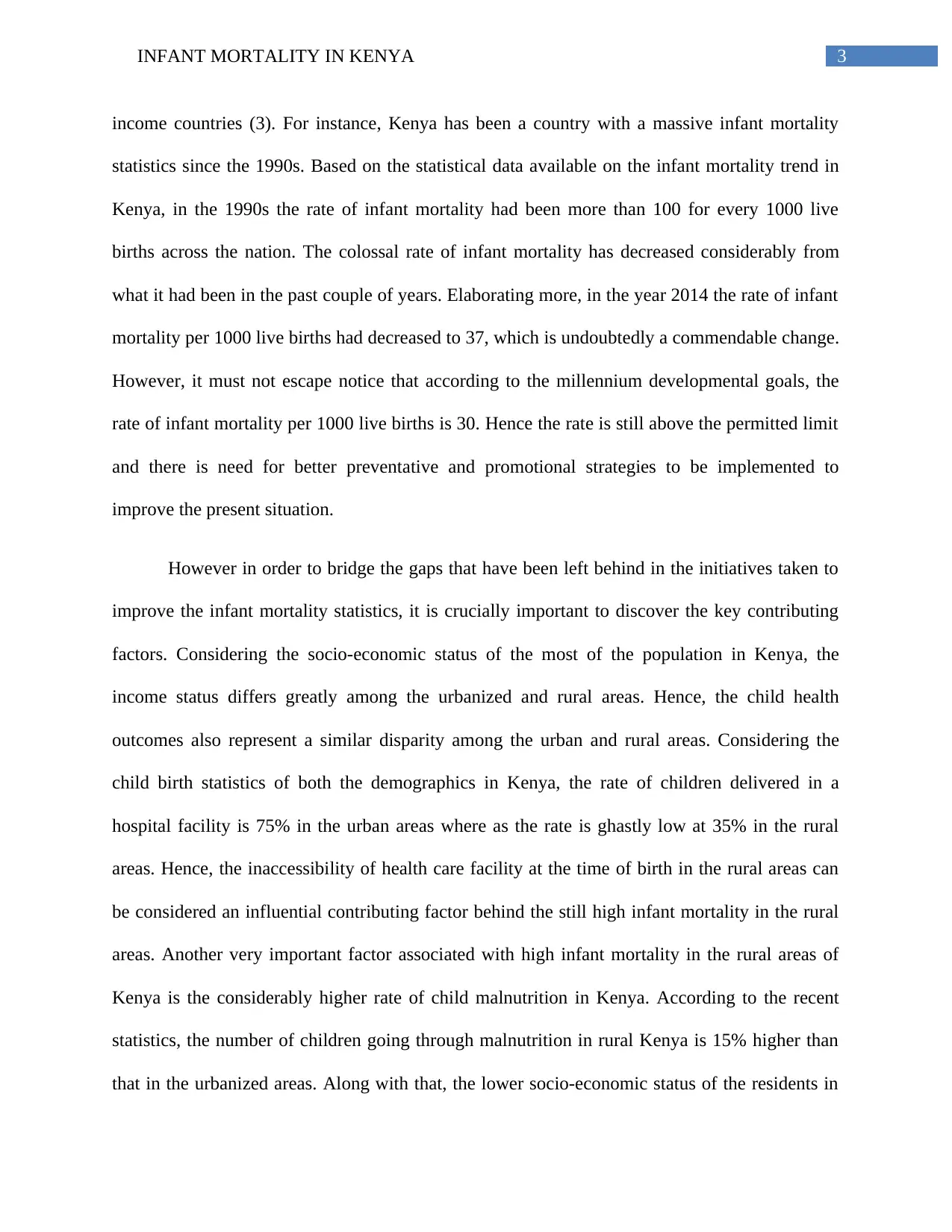
3INFANT MORTALITY IN KENYA
income countries (3). For instance, Kenya has been a country with a massive infant mortality
statistics since the 1990s. Based on the statistical data available on the infant mortality trend in
Kenya, in the 1990s the rate of infant mortality had been more than 100 for every 1000 live
births across the nation. The colossal rate of infant mortality has decreased considerably from
what it had been in the past couple of years. Elaborating more, in the year 2014 the rate of infant
mortality per 1000 live births had decreased to 37, which is undoubtedly a commendable change.
However, it must not escape notice that according to the millennium developmental goals, the
rate of infant mortality per 1000 live births is 30. Hence the rate is still above the permitted limit
and there is need for better preventative and promotional strategies to be implemented to
improve the present situation.
However in order to bridge the gaps that have been left behind in the initiatives taken to
improve the infant mortality statistics, it is crucially important to discover the key contributing
factors. Considering the socio-economic status of the most of the population in Kenya, the
income status differs greatly among the urbanized and rural areas. Hence, the child health
outcomes also represent a similar disparity among the urban and rural areas. Considering the
child birth statistics of both the demographics in Kenya, the rate of children delivered in a
hospital facility is 75% in the urban areas where as the rate is ghastly low at 35% in the rural
areas. Hence, the inaccessibility of health care facility at the time of birth in the rural areas can
be considered an influential contributing factor behind the still high infant mortality in the rural
areas. Another very important factor associated with high infant mortality in the rural areas of
Kenya is the considerably higher rate of child malnutrition in Kenya. According to the recent
statistics, the number of children going through malnutrition in rural Kenya is 15% higher than
that in the urbanized areas. Along with that, the lower socio-economic status of the residents in
income countries (3). For instance, Kenya has been a country with a massive infant mortality
statistics since the 1990s. Based on the statistical data available on the infant mortality trend in
Kenya, in the 1990s the rate of infant mortality had been more than 100 for every 1000 live
births across the nation. The colossal rate of infant mortality has decreased considerably from
what it had been in the past couple of years. Elaborating more, in the year 2014 the rate of infant
mortality per 1000 live births had decreased to 37, which is undoubtedly a commendable change.
However, it must not escape notice that according to the millennium developmental goals, the
rate of infant mortality per 1000 live births is 30. Hence the rate is still above the permitted limit
and there is need for better preventative and promotional strategies to be implemented to
improve the present situation.
However in order to bridge the gaps that have been left behind in the initiatives taken to
improve the infant mortality statistics, it is crucially important to discover the key contributing
factors. Considering the socio-economic status of the most of the population in Kenya, the
income status differs greatly among the urbanized and rural areas. Hence, the child health
outcomes also represent a similar disparity among the urban and rural areas. Considering the
child birth statistics of both the demographics in Kenya, the rate of children delivered in a
hospital facility is 75% in the urban areas where as the rate is ghastly low at 35% in the rural
areas. Hence, the inaccessibility of health care facility at the time of birth in the rural areas can
be considered an influential contributing factor behind the still high infant mortality in the rural
areas. Another very important factor associated with high infant mortality in the rural areas of
Kenya is the considerably higher rate of child malnutrition in Kenya. According to the recent
statistics, the number of children going through malnutrition in rural Kenya is 15% higher than
that in the urbanized areas. Along with that, the lower socio-economic status of the residents in
Paraphrase This Document
Need a fresh take? Get an instant paraphrase of this document with our AI Paraphraser

4INFANT MORTALITY IN KENYA
the rural areas is also reflected on the maternal health and nutrition statistics. Inevitably, the low
birth weight during birth, which is another risk factor for infant mortality, is much more
frequently observed in the rural or slum areas. Furthermore, there are a number of essential
vaccinations that protect the new born children from a lot of deadly diseases, however in the
rural Kenya the percentage of newborn infants receiving the necessary vaccinations is
approximately 8% lesser than the statistics of urbanized regions in Kenya. However, considering
the infant mortality statistics in the urbanized slums, the living conditions like poor water and
extreme lack of hygiene has contributed to a much higher rate of maternal mortality and infant
mortality (4).
Hence on the basis of the above mentioned statistical data, it can be concluded that the
infant mortality rates have decreased noticeably from the past decade in Kenya however the rate
of infant mortality in the rural areas and urbanized slums is still considerably higher. The
considerable contributing factors behind the discontinued pattern of decrease in infant mortality
in the rural and urbanized slums identified are the low socio-economic status and the resultant
living conditions of the individuals (5). Along with that the absolute lack of health literacy or any
knowledge regarding the health promotional activities required for maintaining the health and
safety of the newborn child and the mother is another key contributor in the still high statistics of
infant mortality in Kenya.
Current approaches to reduce mortality:
Despite the still predominating socio-economic determinants, there have been a number
of key preventative initiatives have been taken over the years in attempt to reduce the rate of
child mortality. Both the government and non-government approaches have identified the poor
the rural areas is also reflected on the maternal health and nutrition statistics. Inevitably, the low
birth weight during birth, which is another risk factor for infant mortality, is much more
frequently observed in the rural or slum areas. Furthermore, there are a number of essential
vaccinations that protect the new born children from a lot of deadly diseases, however in the
rural Kenya the percentage of newborn infants receiving the necessary vaccinations is
approximately 8% lesser than the statistics of urbanized regions in Kenya. However, considering
the infant mortality statistics in the urbanized slums, the living conditions like poor water and
extreme lack of hygiene has contributed to a much higher rate of maternal mortality and infant
mortality (4).
Hence on the basis of the above mentioned statistical data, it can be concluded that the
infant mortality rates have decreased noticeably from the past decade in Kenya however the rate
of infant mortality in the rural areas and urbanized slums is still considerably higher. The
considerable contributing factors behind the discontinued pattern of decrease in infant mortality
in the rural and urbanized slums identified are the low socio-economic status and the resultant
living conditions of the individuals (5). Along with that the absolute lack of health literacy or any
knowledge regarding the health promotional activities required for maintaining the health and
safety of the newborn child and the mother is another key contributor in the still high statistics of
infant mortality in Kenya.
Current approaches to reduce mortality:
Despite the still predominating socio-economic determinants, there have been a number
of key preventative initiatives have been taken over the years in attempt to reduce the rate of
child mortality. Both the government and non-government approaches have identified the poor
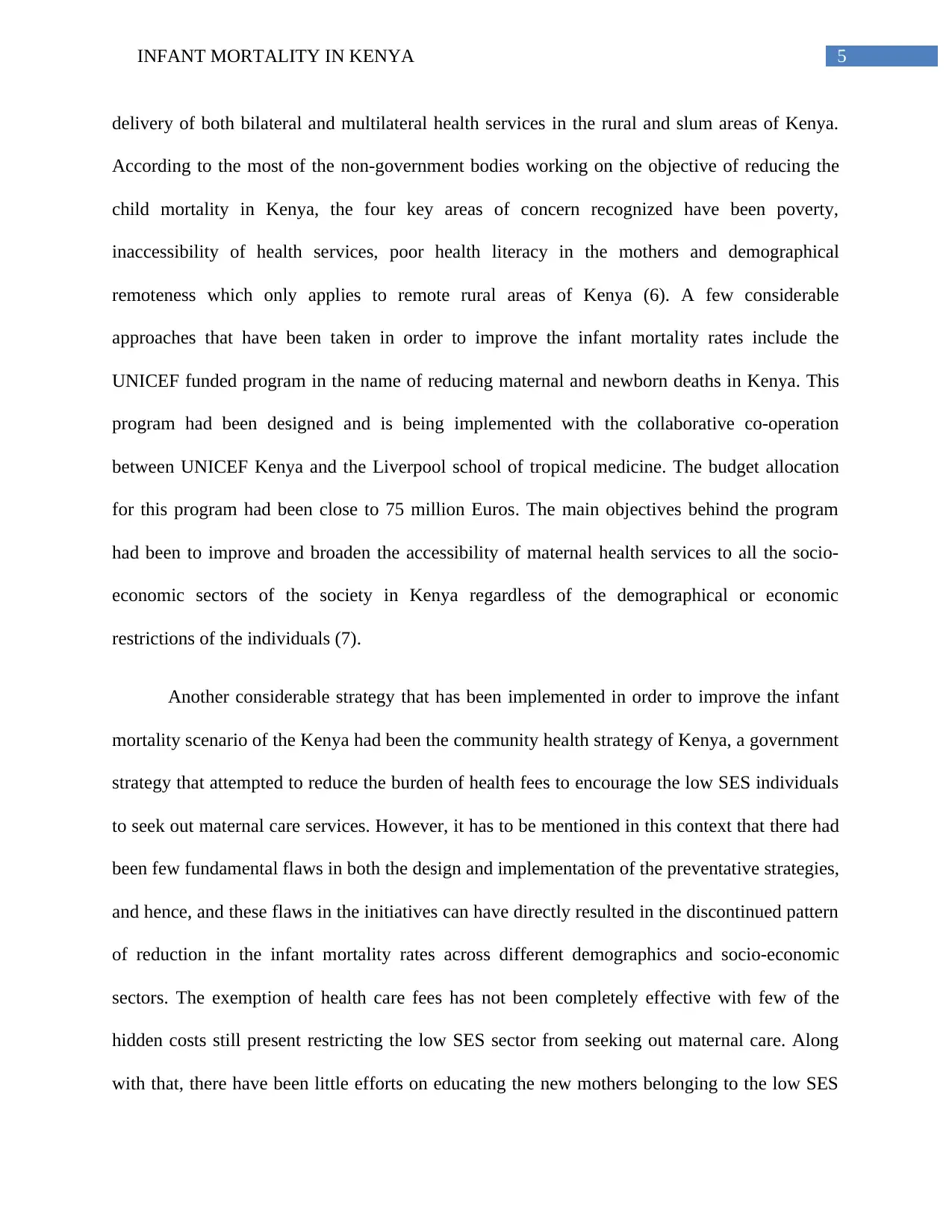
5INFANT MORTALITY IN KENYA
delivery of both bilateral and multilateral health services in the rural and slum areas of Kenya.
According to the most of the non-government bodies working on the objective of reducing the
child mortality in Kenya, the four key areas of concern recognized have been poverty,
inaccessibility of health services, poor health literacy in the mothers and demographical
remoteness which only applies to remote rural areas of Kenya (6). A few considerable
approaches that have been taken in order to improve the infant mortality rates include the
UNICEF funded program in the name of reducing maternal and newborn deaths in Kenya. This
program had been designed and is being implemented with the collaborative co-operation
between UNICEF Kenya and the Liverpool school of tropical medicine. The budget allocation
for this program had been close to 75 million Euros. The main objectives behind the program
had been to improve and broaden the accessibility of maternal health services to all the socio-
economic sectors of the society in Kenya regardless of the demographical or economic
restrictions of the individuals (7).
Another considerable strategy that has been implemented in order to improve the infant
mortality scenario of the Kenya had been the community health strategy of Kenya, a government
strategy that attempted to reduce the burden of health fees to encourage the low SES individuals
to seek out maternal care services. However, it has to be mentioned in this context that there had
been few fundamental flaws in both the design and implementation of the preventative strategies,
and hence, and these flaws in the initiatives can have directly resulted in the discontinued pattern
of reduction in the infant mortality rates across different demographics and socio-economic
sectors. The exemption of health care fees has not been completely effective with few of the
hidden costs still present restricting the low SES sector from seeking out maternal care. Along
with that, there have been little efforts on educating the new mothers belonging to the low SES
delivery of both bilateral and multilateral health services in the rural and slum areas of Kenya.
According to the most of the non-government bodies working on the objective of reducing the
child mortality in Kenya, the four key areas of concern recognized have been poverty,
inaccessibility of health services, poor health literacy in the mothers and demographical
remoteness which only applies to remote rural areas of Kenya (6). A few considerable
approaches that have been taken in order to improve the infant mortality rates include the
UNICEF funded program in the name of reducing maternal and newborn deaths in Kenya. This
program had been designed and is being implemented with the collaborative co-operation
between UNICEF Kenya and the Liverpool school of tropical medicine. The budget allocation
for this program had been close to 75 million Euros. The main objectives behind the program
had been to improve and broaden the accessibility of maternal health services to all the socio-
economic sectors of the society in Kenya regardless of the demographical or economic
restrictions of the individuals (7).
Another considerable strategy that has been implemented in order to improve the infant
mortality scenario of the Kenya had been the community health strategy of Kenya, a government
strategy that attempted to reduce the burden of health fees to encourage the low SES individuals
to seek out maternal care services. However, it has to be mentioned in this context that there had
been few fundamental flaws in both the design and implementation of the preventative strategies,
and hence, and these flaws in the initiatives can have directly resulted in the discontinued pattern
of reduction in the infant mortality rates across different demographics and socio-economic
sectors. The exemption of health care fees has not been completely effective with few of the
hidden costs still present restricting the low SES sector from seeking out maternal care. Along
with that, there have been little efforts on educating the new mothers belonging to the low SES
⊘ This is a preview!⊘
Do you want full access?
Subscribe today to unlock all pages.

Trusted by 1+ million students worldwide
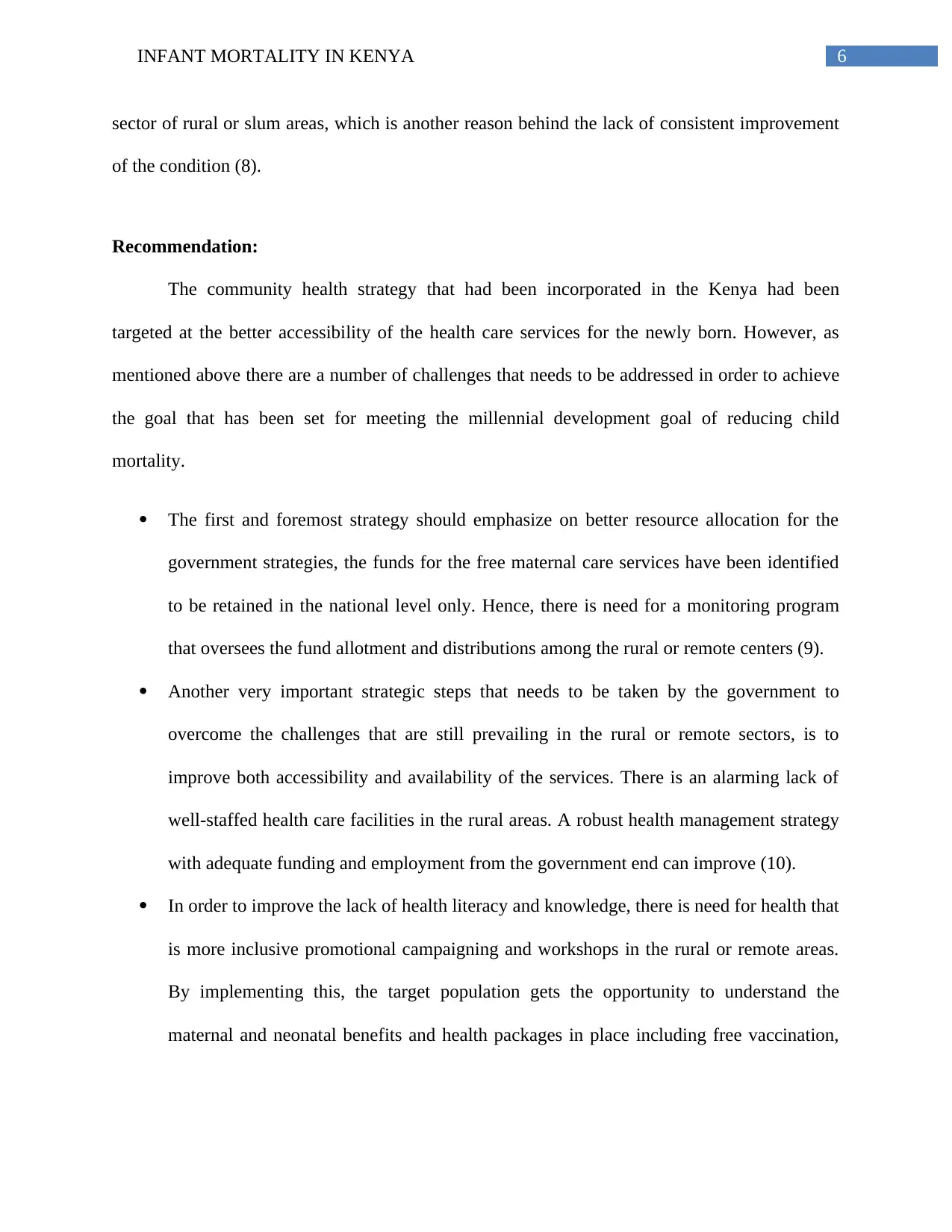
6INFANT MORTALITY IN KENYA
sector of rural or slum areas, which is another reason behind the lack of consistent improvement
of the condition (8).
Recommendation:
The community health strategy that had been incorporated in the Kenya had been
targeted at the better accessibility of the health care services for the newly born. However, as
mentioned above there are a number of challenges that needs to be addressed in order to achieve
the goal that has been set for meeting the millennial development goal of reducing child
mortality.
The first and foremost strategy should emphasize on better resource allocation for the
government strategies, the funds for the free maternal care services have been identified
to be retained in the national level only. Hence, there is need for a monitoring program
that oversees the fund allotment and distributions among the rural or remote centers (9).
Another very important strategic steps that needs to be taken by the government to
overcome the challenges that are still prevailing in the rural or remote sectors, is to
improve both accessibility and availability of the services. There is an alarming lack of
well-staffed health care facilities in the rural areas. A robust health management strategy
with adequate funding and employment from the government end can improve (10).
In order to improve the lack of health literacy and knowledge, there is need for health that
is more inclusive promotional campaigning and workshops in the rural or remote areas.
By implementing this, the target population gets the opportunity to understand the
maternal and neonatal benefits and health packages in place including free vaccination,
sector of rural or slum areas, which is another reason behind the lack of consistent improvement
of the condition (8).
Recommendation:
The community health strategy that had been incorporated in the Kenya had been
targeted at the better accessibility of the health care services for the newly born. However, as
mentioned above there are a number of challenges that needs to be addressed in order to achieve
the goal that has been set for meeting the millennial development goal of reducing child
mortality.
The first and foremost strategy should emphasize on better resource allocation for the
government strategies, the funds for the free maternal care services have been identified
to be retained in the national level only. Hence, there is need for a monitoring program
that oversees the fund allotment and distributions among the rural or remote centers (9).
Another very important strategic steps that needs to be taken by the government to
overcome the challenges that are still prevailing in the rural or remote sectors, is to
improve both accessibility and availability of the services. There is an alarming lack of
well-staffed health care facilities in the rural areas. A robust health management strategy
with adequate funding and employment from the government end can improve (10).
In order to improve the lack of health literacy and knowledge, there is need for health that
is more inclusive promotional campaigning and workshops in the rural or remote areas.
By implementing this, the target population gets the opportunity to understand the
maternal and neonatal benefits and health packages in place including free vaccination,
Paraphrase This Document
Need a fresh take? Get an instant paraphrase of this document with our AI Paraphraser
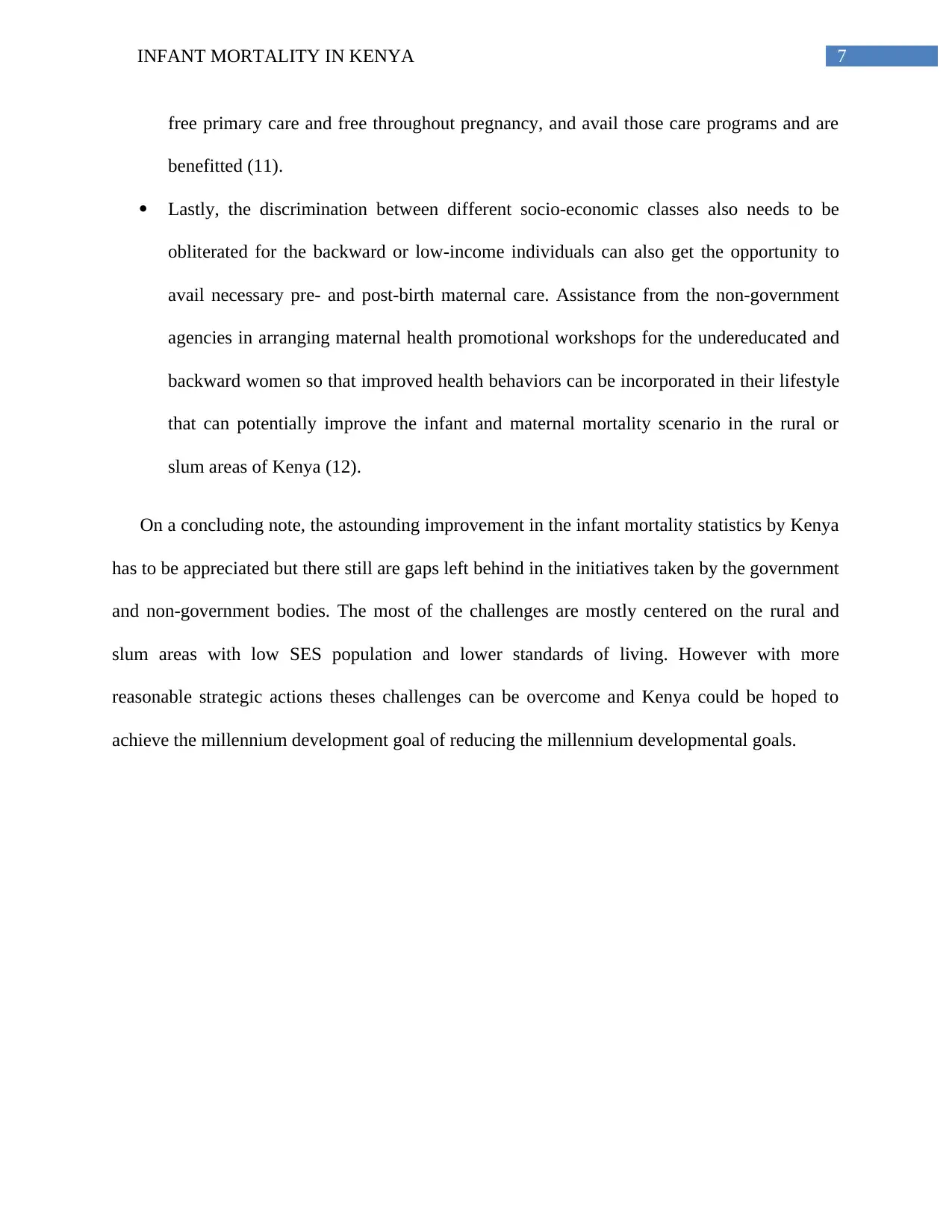
7INFANT MORTALITY IN KENYA
free primary care and free throughout pregnancy, and avail those care programs and are
benefitted (11).
Lastly, the discrimination between different socio-economic classes also needs to be
obliterated for the backward or low-income individuals can also get the opportunity to
avail necessary pre- and post-birth maternal care. Assistance from the non-government
agencies in arranging maternal health promotional workshops for the undereducated and
backward women so that improved health behaviors can be incorporated in their lifestyle
that can potentially improve the infant and maternal mortality scenario in the rural or
slum areas of Kenya (12).
On a concluding note, the astounding improvement in the infant mortality statistics by Kenya
has to be appreciated but there still are gaps left behind in the initiatives taken by the government
and non-government bodies. The most of the challenges are mostly centered on the rural and
slum areas with low SES population and lower standards of living. However with more
reasonable strategic actions theses challenges can be overcome and Kenya could be hoped to
achieve the millennium development goal of reducing the millennium developmental goals.
free primary care and free throughout pregnancy, and avail those care programs and are
benefitted (11).
Lastly, the discrimination between different socio-economic classes also needs to be
obliterated for the backward or low-income individuals can also get the opportunity to
avail necessary pre- and post-birth maternal care. Assistance from the non-government
agencies in arranging maternal health promotional workshops for the undereducated and
backward women so that improved health behaviors can be incorporated in their lifestyle
that can potentially improve the infant and maternal mortality scenario in the rural or
slum areas of Kenya (12).
On a concluding note, the astounding improvement in the infant mortality statistics by Kenya
has to be appreciated but there still are gaps left behind in the initiatives taken by the government
and non-government bodies. The most of the challenges are mostly centered on the rural and
slum areas with low SES population and lower standards of living. However with more
reasonable strategic actions theses challenges can be overcome and Kenya could be hoped to
achieve the millennium development goal of reducing the millennium developmental goals.
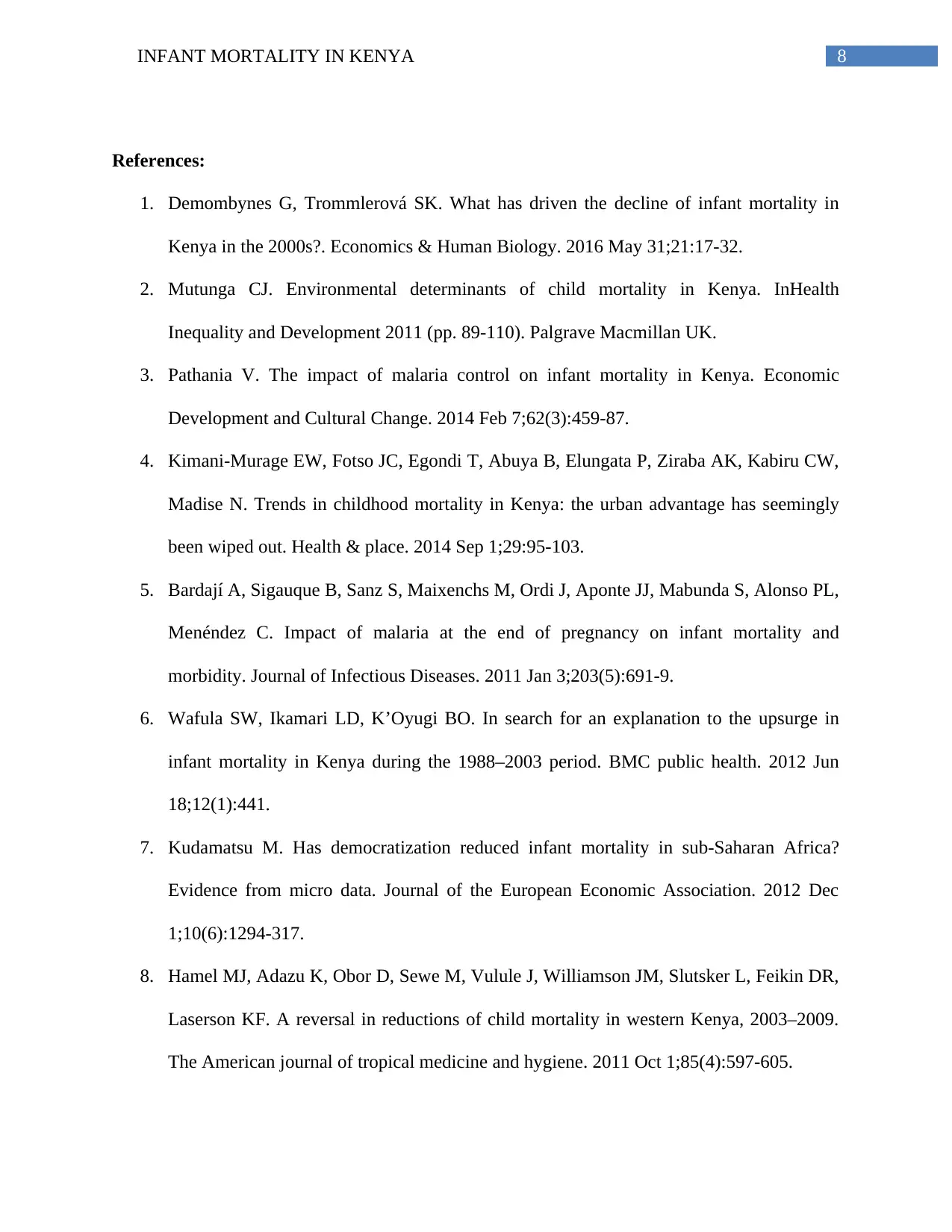
8INFANT MORTALITY IN KENYA
References:
1. Demombynes G, Trommlerová SK. What has driven the decline of infant mortality in
Kenya in the 2000s?. Economics & Human Biology. 2016 May 31;21:17-32.
2. Mutunga CJ. Environmental determinants of child mortality in Kenya. InHealth
Inequality and Development 2011 (pp. 89-110). Palgrave Macmillan UK.
3. Pathania V. The impact of malaria control on infant mortality in Kenya. Economic
Development and Cultural Change. 2014 Feb 7;62(3):459-87.
4. Kimani-Murage EW, Fotso JC, Egondi T, Abuya B, Elungata P, Ziraba AK, Kabiru CW,
Madise N. Trends in childhood mortality in Kenya: the urban advantage has seemingly
been wiped out. Health & place. 2014 Sep 1;29:95-103.
5. Bardají A, Sigauque B, Sanz S, Maixenchs M, Ordi J, Aponte JJ, Mabunda S, Alonso PL,
Menéndez C. Impact of malaria at the end of pregnancy on infant mortality and
morbidity. Journal of Infectious Diseases. 2011 Jan 3;203(5):691-9.
6. Wafula SW, Ikamari LD, K’Oyugi BO. In search for an explanation to the upsurge in
infant mortality in Kenya during the 1988–2003 period. BMC public health. 2012 Jun
18;12(1):441.
7. Kudamatsu M. Has democratization reduced infant mortality in sub-Saharan Africa?
Evidence from micro data. Journal of the European Economic Association. 2012 Dec
1;10(6):1294-317.
8. Hamel MJ, Adazu K, Obor D, Sewe M, Vulule J, Williamson JM, Slutsker L, Feikin DR,
Laserson KF. A reversal in reductions of child mortality in western Kenya, 2003–2009.
The American journal of tropical medicine and hygiene. 2011 Oct 1;85(4):597-605.
References:
1. Demombynes G, Trommlerová SK. What has driven the decline of infant mortality in
Kenya in the 2000s?. Economics & Human Biology. 2016 May 31;21:17-32.
2. Mutunga CJ. Environmental determinants of child mortality in Kenya. InHealth
Inequality and Development 2011 (pp. 89-110). Palgrave Macmillan UK.
3. Pathania V. The impact of malaria control on infant mortality in Kenya. Economic
Development and Cultural Change. 2014 Feb 7;62(3):459-87.
4. Kimani-Murage EW, Fotso JC, Egondi T, Abuya B, Elungata P, Ziraba AK, Kabiru CW,
Madise N. Trends in childhood mortality in Kenya: the urban advantage has seemingly
been wiped out. Health & place. 2014 Sep 1;29:95-103.
5. Bardají A, Sigauque B, Sanz S, Maixenchs M, Ordi J, Aponte JJ, Mabunda S, Alonso PL,
Menéndez C. Impact of malaria at the end of pregnancy on infant mortality and
morbidity. Journal of Infectious Diseases. 2011 Jan 3;203(5):691-9.
6. Wafula SW, Ikamari LD, K’Oyugi BO. In search for an explanation to the upsurge in
infant mortality in Kenya during the 1988–2003 period. BMC public health. 2012 Jun
18;12(1):441.
7. Kudamatsu M. Has democratization reduced infant mortality in sub-Saharan Africa?
Evidence from micro data. Journal of the European Economic Association. 2012 Dec
1;10(6):1294-317.
8. Hamel MJ, Adazu K, Obor D, Sewe M, Vulule J, Williamson JM, Slutsker L, Feikin DR,
Laserson KF. A reversal in reductions of child mortality in western Kenya, 2003–2009.
The American journal of tropical medicine and hygiene. 2011 Oct 1;85(4):597-605.
⊘ This is a preview!⊘
Do you want full access?
Subscribe today to unlock all pages.

Trusted by 1+ million students worldwide
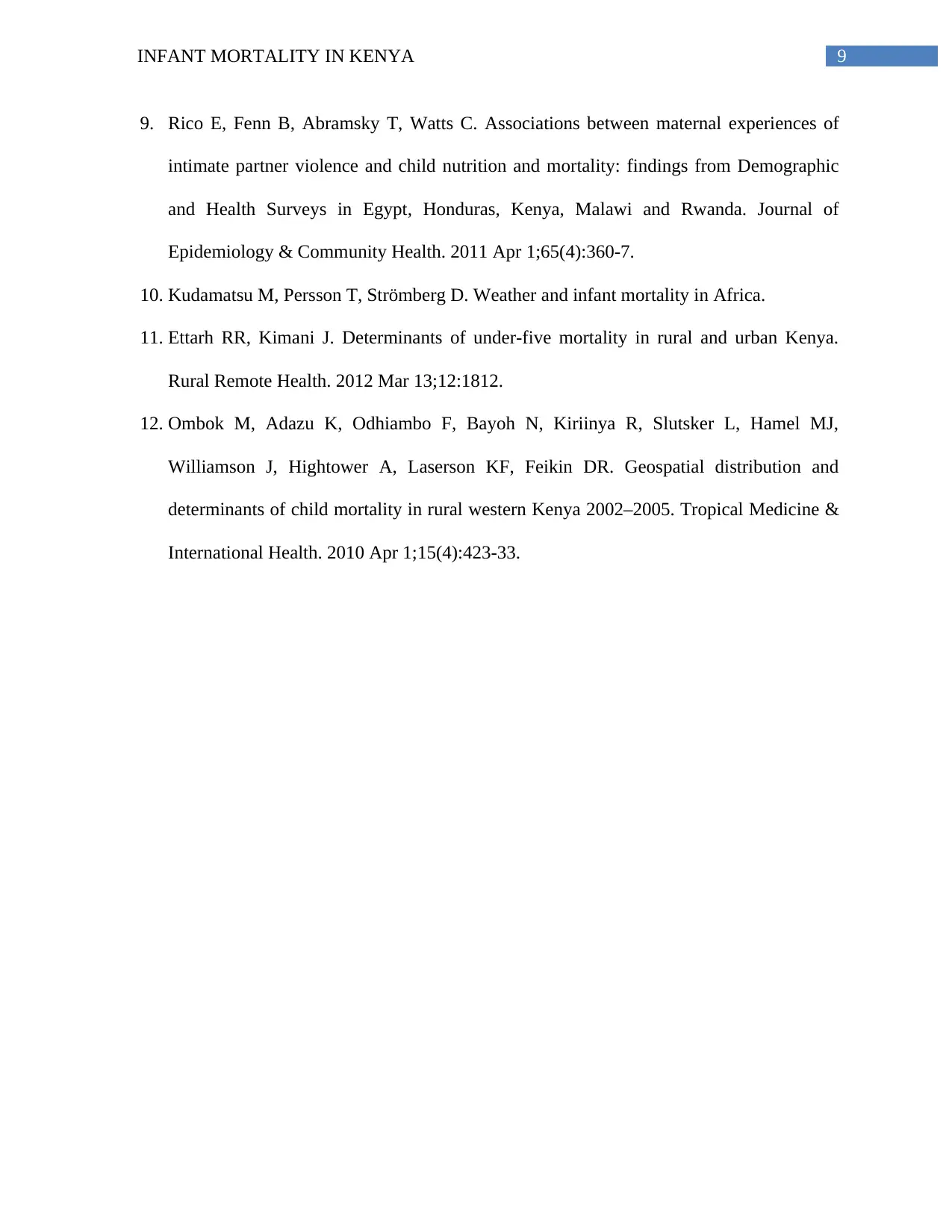
9INFANT MORTALITY IN KENYA
9. Rico E, Fenn B, Abramsky T, Watts C. Associations between maternal experiences of
intimate partner violence and child nutrition and mortality: findings from Demographic
and Health Surveys in Egypt, Honduras, Kenya, Malawi and Rwanda. Journal of
Epidemiology & Community Health. 2011 Apr 1;65(4):360-7.
10. Kudamatsu M, Persson T, Strömberg D. Weather and infant mortality in Africa.
11. Ettarh RR, Kimani J. Determinants of under-five mortality in rural and urban Kenya.
Rural Remote Health. 2012 Mar 13;12:1812.
12. Ombok M, Adazu K, Odhiambo F, Bayoh N, Kiriinya R, Slutsker L, Hamel MJ,
Williamson J, Hightower A, Laserson KF, Feikin DR. Geospatial distribution and
determinants of child mortality in rural western Kenya 2002–2005. Tropical Medicine &
International Health. 2010 Apr 1;15(4):423-33.
9. Rico E, Fenn B, Abramsky T, Watts C. Associations between maternal experiences of
intimate partner violence and child nutrition and mortality: findings from Demographic
and Health Surveys in Egypt, Honduras, Kenya, Malawi and Rwanda. Journal of
Epidemiology & Community Health. 2011 Apr 1;65(4):360-7.
10. Kudamatsu M, Persson T, Strömberg D. Weather and infant mortality in Africa.
11. Ettarh RR, Kimani J. Determinants of under-five mortality in rural and urban Kenya.
Rural Remote Health. 2012 Mar 13;12:1812.
12. Ombok M, Adazu K, Odhiambo F, Bayoh N, Kiriinya R, Slutsker L, Hamel MJ,
Williamson J, Hightower A, Laserson KF, Feikin DR. Geospatial distribution and
determinants of child mortality in rural western Kenya 2002–2005. Tropical Medicine &
International Health. 2010 Apr 1;15(4):423-33.
1 out of 10
Related Documents
Your All-in-One AI-Powered Toolkit for Academic Success.
+13062052269
info@desklib.com
Available 24*7 on WhatsApp / Email
![[object Object]](/_next/static/media/star-bottom.7253800d.svg)
Unlock your academic potential
Copyright © 2020–2025 A2Z Services. All Rights Reserved. Developed and managed by ZUCOL.





